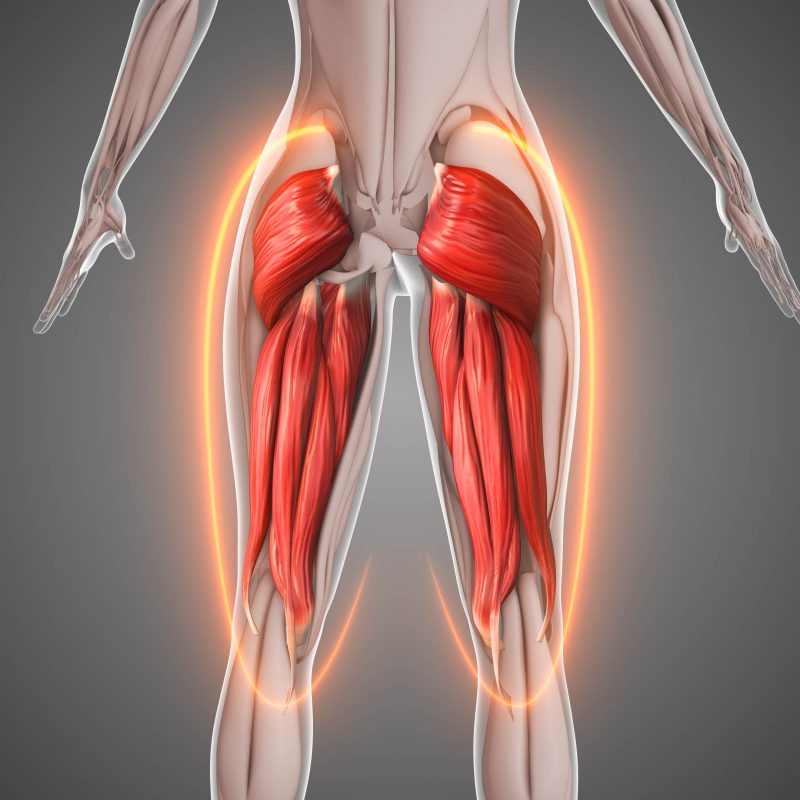
As the largest muscle group in the body, glutes comprise the major part of the buttocks. These muscles, vital for athletic performance, also come into play during mundane daily movements such as standing upright, walking and running. In this article we will delve into the anatomy of the gluteus musculature, including the most optimal manner in which to activate the muscles, a crucial step in properly engaging the glutes prior to any lower body workout.
Analysis of the Anatomy
The powerful glutes function as a result of three separate muscles located deep within the buttocks. Each distinct muscle plays a role in hip extension, external rotation, and pelvic stabilization.
- Gluteus Maximus: the largest of the three, this muscle holds the primary responsibility of hip extension and external rotation. This muscle gets recruited during such power moves as deadlifts and squats. It also provides the shapeliness of the buttocks
- Gluteus Medius: found on the outer surface of the pelvis, this smaller muscle serves to stabilize the hip and pelvis. It comes into play when executing movements that require balance and lateral stability, such as side lunges and single-leg exercises
- Gluteus Minimus: located beneath the gluteus medius, this smallest muscle of the three assists in hip rotation and stabilization. It also functions to provide smooth, controlled movements during various exercises.
Overcoming Gluteal Weakness
Weak gluteal muscles, a commonly overlooked problem, can negatively impact one’s posture, stability, and movement. Trainers often hear complaints from clients regarding lower back pain, knee and hip discomfort and even ankle pain. Very often we find that weak glutes have contributed to these issues, if not actually caused them.
Weaking in the backside can also lead to instability, since the muscles simply cannot seem to provide the proper/necessary stability for hip and knee joints. This in turn places undue strain on the joints, leading to a greater chance of injury. Trainers encounter this scenario often, mostly in individuals whose jobs require them to sit all throughout an 8-hour workday.
Better Together
When trying to strengthen a particular muscle group, we must understand that in truth, complete muscle isolation does not necessarily occur. Therefore, with a goal of targeting the upper portion of the buttocks, we must actually activate and train both the gluteus medius and the gluteus maximus. These muscles facilitate movement of the legs away from the midline of the body, or abduction, at the hip joint. Hip abduction moves, horizontally-loaded hip extension exercises, and standing resistance-banded abduction come into play here for optimal glutes shaping. One research study revealed that training on a hip abduction machine elicited the greatest gluteus medius activation while igniting the least tensor fascia latae activation, when compared to other abduction exercises.
Exercise Selection
While all personal trainers will have their favorite method of choosing exercises to target specific parts of a client’s body, exercise professionals tend to agree on the most optimal moves for training the glutes. We will present additional workout programs later in the article; but for now, we will explore the most basic glute-shaping moves:
- Squats: probably the most effective exercise for strengthening the glutes, one can execute squats using body weight only, or with added resistance such as a barbell or dumbbells. Deep squats performed with toes slightly elevated force the glutes as well as the entire posterior chain to work hard.
- Lunges: a simple yet effective exercise for targeting the glutes, one can perform lunges in all directions (forward, backward and laterally), again using body weight only, or with the additional load of a barbell or dumbbells.
- Step-Ups: this exercise targets both the glutes and hamstrings, and like the aforementioned moves, one can choose to work with just his body weight or with added resistance by holding dumbbells.
- Glute Bridges: this move can target the glutes and core simultaneously. While lying on his back with knees bent and feet flat on the floor, one then elevates the hips as high as possible (ideally aiming to get the quads parallel to the ceiling), squeezing glutes at the top of the move.
- Clamshells: this exercise targets the glutes and hip abductors simultaneously. While positioned on his side with knees bent and feet together, one can lift the top knee as high as possible, once again squeezing the glutes at the top of the move.
Hip Thrusts versus Back Squats
Many advanced athletes consider the hip thrust as one of the top glutes recruiting moves one can perform. However, exercise physiology studies may not concur. A research study compared the effects of back squats and hip thrusts on muscle strength and hypertrophy in seasoned female athletic subjects. Twenty-two participants randomly engaged in 12 weeks of either back squats or hip thrusts. Prior to and following the 12-week experiment, the scientists measured quadriceps femoris and gluteus maximus muscle thickness on all participants, as well as noting their 1 repetition maximum (1RM) test on their assigned exercise. Both groups demonstrated significantly increased hip extensors progress and hip thrust 1RM. However, the improvements seen in the subjects who trained with back squats proved more significant with regard to thickness of the quadriceps femoris and gluteus maximus. In addition, these subjects also boosted their back squat 1 RM load. The final results deemed the back squat more efficient of a training exercise, since it resulted in greater muscle hypertrophy of the quadriceps femoris and gluteus maximus.
The barbell back squat, a knee-dominant exercise, does in fact achieve high amounts of hip and knee extensor activation. Some research indicates that squats may in fact top hip thrusts and deadlifts at activating both the glutes and the quads. Still, the hip thrust does seem to induce high amounts of glute activation. This particular move also offers a high potential for a posterior pelvic tilt. The posterior/pelvic tilt serves as a key part of the lockout (the top of the move) of the hip thrust. Other lower body exercises may likewise require a lockout, but the hip thrust provides the highest potential for a solid lockout. The hip thrust also allows for nearly unlimited loading, due to the high loading capacity of barbells and hip thrust machines.
Another group of researchers undertook the study of how set-volume equated resistance training using either the back squat or hip thrust might affect hypertrophy and strength. Following nine weeks of subjects’ training with a focus on either hip thrusts or back squats, the scientists noted that both exercises elicited similar gluteal hypertrophy, while the back squats seemed to cause greater gains in quad/inner thigh muscle hypertrophy.
One training tidbit to keep in mind: Since hip thrusts usually prove less arduous and therefore less exhausting than heavy back squats, many athletes find that they can engage in hip thrusts more often and with greater volume in their regular glutes workouts. A common favorite involves the “8x8x8 glute training” method. In this workout, the athlete does the following:
- 8 full-range hip thrusts
- 8 partial range hip thrusts (basically glute bridges)
- Hold the top part of the exercise for 8 full seconds.
A simple change in one’s stance, body positioning (feet wider apart), or the addition of a resistance band can alter a hip thrust to more specifically target the upper glutes.
Resistance Bands in Glutes Training
Resistance bands can serve as a versatile tool for glute training; their lighter weight makes them infinitely easier to bring along than dumbbells, so athletes can take them anywhere. Whether training at home, in the gym, or on a vacation/hike/training in any off-site class format, resistance bands can help foster a strong and toned backside.
Beginners may want to keep in mind the following tips for using resistance bands effectively:
- Tensile Strength: Begin with a light resistance band and gradually increase the tension as strength improves. This approach helps prevent injury while still ensuring that glutes muscles get sufficiently challenged.
- Pay Attention to Form: Effective glutes training requires low and controlled movements. Pay attention to form in order to maximize glute activation.
- Variety: Incorporate a range of resistance band exercises to target the glutes from different angles. Banded squats, lunges, and deadlifts make excellent choices for comprehensive glute engagement.
More Options: Deadlifts and Glute-Focused Bulgarian Split Squats
The need for variety does not solely apply to resistance band training. Solely executing hip thrusts and back squats will eventually make for a boring glutes workout, one that may end in clients losing interest.
A conventional deadlift, yet another hip-dominant move that boasts the potential to reach high hip extension forces, allows for progressive overload, an important concept we will also cover. When done with proper form, deadlifts will elicit high levels of glute activation. Romanian deadlifts and stiff-legged deadlifts can likewise successfully fire the glutes. Another option in this same group, the Bulgarian split squat, focuses on balance as well as hip extension. Studies have revealed that when compared to back squats, the Bulgarian split squat offers better glutes recruitment.
Designing Effective Workout Programs
Training specifically for gluteal development requires a great deal of knowledge, as we have seen, as well as advance planning. As with any other muscle group, trainers find it essential to design a well-structured program that incorporates progressive overload. Only by gradually increasing the weight, resistance, or repetitions over time can one truly provide a continuous challenge to the muscles, thereby fostering greater hypertrophy.
Here we suggest some tips for effective programming including progressive overload:
- Week 1: a prudent baseline program includes 2-3 sets of 8-12 reps for each exercise, the ideal range for building both lean muscle mass and strength.
- Incremental Increases: increase the weight or resistance by 2.5-5lbs. every 2 weeks or so, depending on client’s comfort level and adaptation.
- Introduce Variety: with a goal of hitting the glutes from all different angles, include moves such as squats, lunges, deadlifts, and glute bridges. Such a process will encourage comprehensive glute development.
- Add in some more sophisticated techniques: As an even greater challenge to the muscles, incorporating advanced techniques such as drop sets, supersets, and rest-pause training can help break through plateaus for smooth and continuous growth.
When designing glute training, keep in mind the need for metabolic stress, which manifests itself when the client actually feels the muscular “burn” or can visually observe a “pump”. This end goal gets accomplished through higher reps, lighter weights and shorter rest periods. We can consider this as a final burn-out of the muscle fibers, typically used as a set of finishing moves near or at the end of the workout.
Frequency and Numbers of Sets
Since bodies respond in unique ways to differing stimuli, the question of quantity often gets raised with regard to how often one should train glutes as well as the best number of exercises to include before fatigue takes over. The answer will vary depending largely on the client’s goals as well as his current fitness level.
For beginners, 3-4 glute exercises per session typically make for a good starting point. Intermediate and advanced lifters may benefit from adding complexity, aiming for 5-6 different exercises in order to fully engage the glute muscles.
Another essential factor revolves around how often one should train glutes. The general recommendation here does not vary much from training other major body parts, typically 2-3 times a week, allowing for proper muscle recovery and growth. As always, strive for at least 48 hours of rest between each glute workouts, so as to optimize recovery and avoid overtraining/injury.
Below we present some exercise options for designing beginner, intermediate and advanced glutes workouts ~
Beginner Glute Workout
- Bodyweight Squats
- Glute Bridges
- Lunges
- Donkey Kicks
Intermediate and Advanced Glute Workout
- Hip Thrusts with Barbell
- Squats with Resistance Bands
- Curtsy Lunges
- Romanian Deadlifts
- Smith Machine Glute Bridges
- Bulgarian Split Squat
The Weekly Sample Plan for All Clients
The dedicated athlete knows the importance of advance planning, so that he arrives at the gym highly motivated, prepared and ready to train hard. To that end, we offer a sample 1-week glutes workout that trainers can tweak to suit the needs of all clients, regardless of their experience:
Day 1: Compound Focus
- Barbell Squats: 4 sets of 8-10 reps
- Romanian Deadlifts: 4 sets of 8-10 reps
- Goblet Squats: 3 sets of 12-15 reps
Day 2: Isolation and Smith Machine
- Smith Machine Glute Bridges: 4 sets of 12-15 reps
- Curtsy Lunges: 3 sets of 12 reps per leg
- Cable Kickbacks: 3 sets of 15 reps per leg
Day 3: Combination and Bodyweight
- Lunges: 4 sets of 12 reps per leg
- Glute Bridges: 3 sets of 20 reps
- Donkey Kicks: 3 sets of 15 reps per leg
A program such as this will guarantee that the glutes get trained at a variety of angles while offering sufficient stimulus to yield both strength and muscular development.
Final Thoughts
Having a thorough understanding of the anatomy of the muscles one sets out to train helps foster proper form and technique. If you have an affinity for anatomy, particularly as it related to strength training and program designs, stay tuned for our upcoming article on the anatomy and training of the deltoids!
References:
https://pubmed.ncbi.nlm.nih.gov/34055144/
https://www.biorxiv.org/content/10.1101/2023.06.21.545949v2
https://pubmed.ncbi.nlm.nih.gov/31230110/
https://pubmed.ncbi.nlm.nih.gov/28538321/
https://pubmed.ncbi.nlm.nih.gov/31975359/






